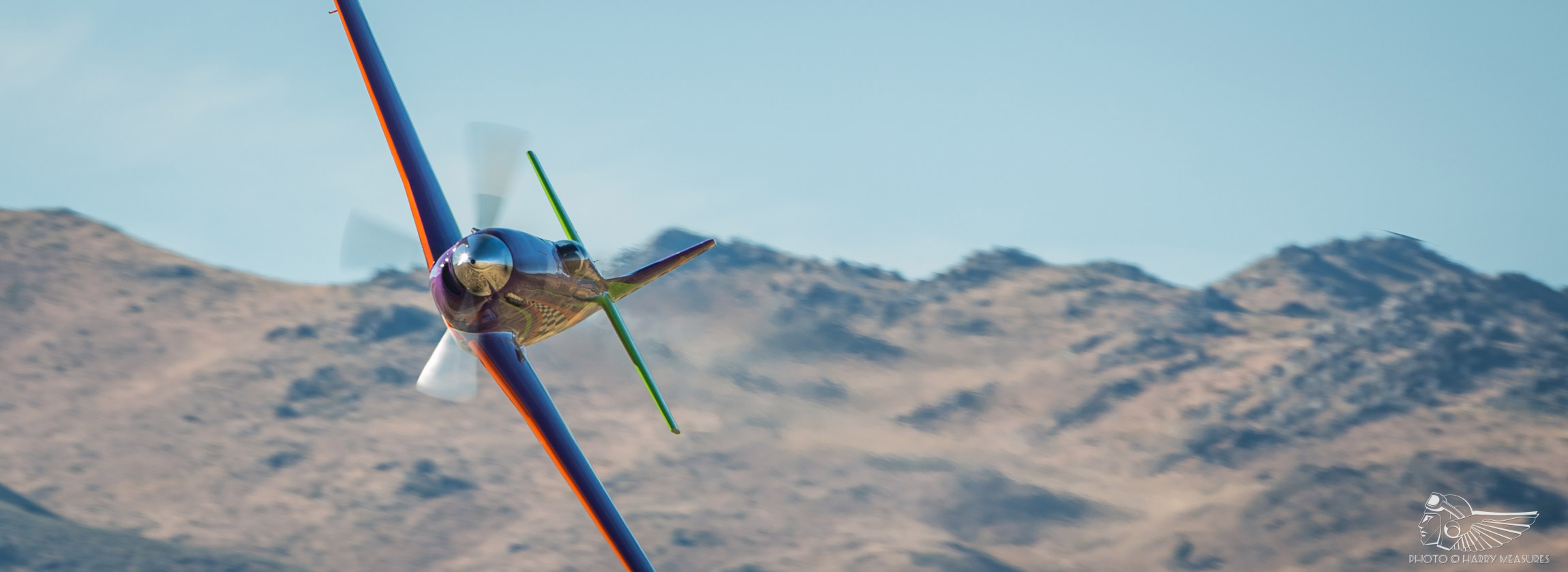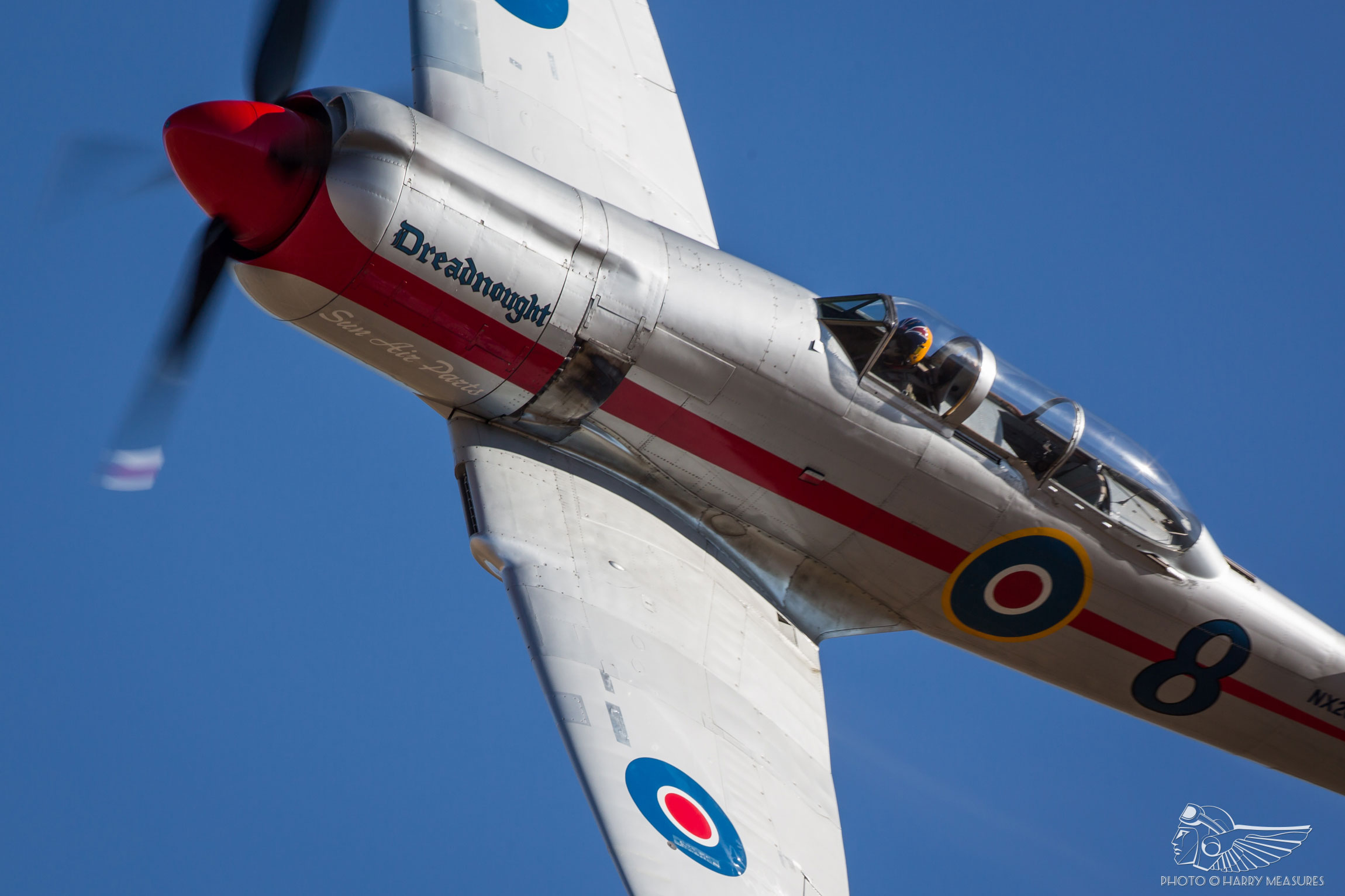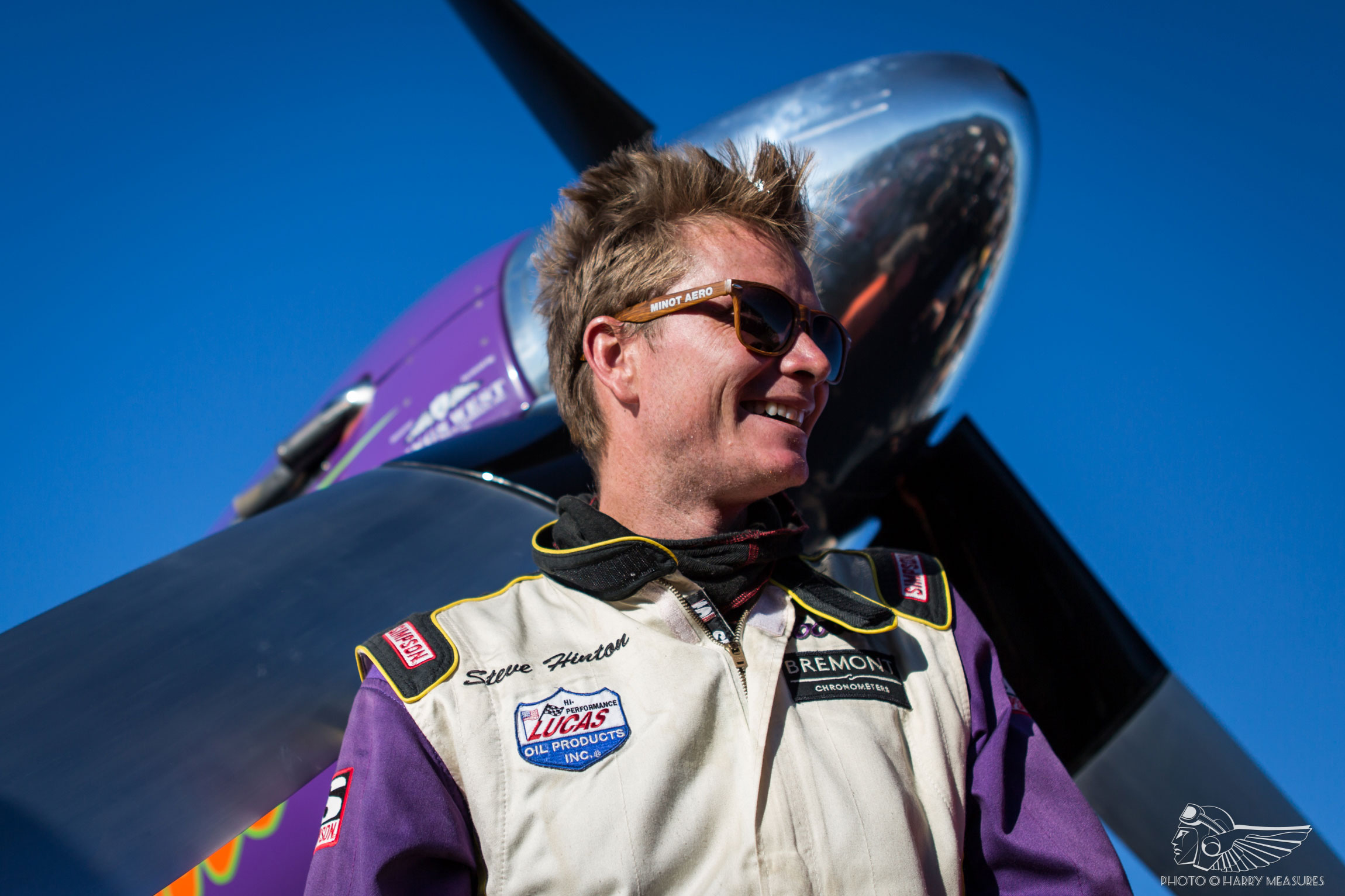The late afternoon heat haze shimmers and ripples amongst the pylons out in the valley. With race week nearly concluded, the Gold Unlimited is the last class to take to the field. High to the south, a tendril of fine white smoke marks the pace aircraft, the Planes of Fame (PoF) T-33 piloted by Steve Hinton, flanked by the field of racers. Slowly the formation banks back towards Reno Stead from the south-east, descending rapidly as they do so. Just before the airfield boundary, the T-33 pulls up into a high orbit, leaving the Unlimited class to roar onto the course to the call of: “Gentlemen, we have a race!”
Held annually at Reno Stead Airport, the Reno Air Race is an event that the vast majority of, if not all, aviation enthusiasts will be familiar with. Most will probably also have a polarised view of them – especially of the Unlimited class: either as impossibly cool, or a way to ruin a perfectly good warbird in the pursuit of power, drag reduction, and, ultimately, speed. The races are in their 54th year in 2017, and one could argue that the air racing culture is just about as old as the current warbird preservation movement itself. Certainly, in 1964, these aircraft were not deemed as precious as they are today, and you have to wonder if some, such as “Rare Bear”, would even be around today if not for people like Lyle Shelton dragging hulks from fields with the view to rebuilding them as air racers. Some of the aircraft have carved out a history of their own – names like “Czech Mate”, “Voodoo” and “Dreadnought” are synonymous with the air races.
It’s worth noting at this point that not all of the Unlimited entries are heavily modified, or modified at all. Notably, 2016’s Unlimited class saw the PoF P-51A “Mrs. Virginia” take the field – a far cry from the purpose-built racers. Another staple of the Unlimited field, “Sparkie”, owned and operated by Brant and Steve Seghetti, returned in a new paint scheme. Formerly painted in the Jelly Belly sponsorship livery, it arrived resplendent in its original 15th Air Force, 52nd Fighter Group, 5th Fighter Squadron scheme – that of Ralph “Doc” Watson’s mount (Deputy Wing Commander 15th Air Force, charged with overseeing the 31st, 52nd, 325th and 332nd Fighter Groups), adorned with the moniker “Blondie”. It was in this airframe that he scored two combat victories, including his fifth, Ace-making kill.
The Races themselves are spread out over a week in September, with the qualifying sessions being held on the Monday, Tuesday, and Wednesday, and the races kicking off from around Thursday onwards. The culmination is on Sunday, with the Bronze, Silver and Gold finals. Dispersed in amongst the races are airshow performers, which vary from surprise US Air Force flypasts, aerobatic acts such as Jim Peitz in his Bonanza, flying a masterful aerobatic routine in 2016, to the US Navy air demonstration team, the Blue Angels. Flying daily from Thursday onwards at last year’s event, the Blues’ display was full of generous helpings of afterburner, tight formation photo passes and ‘sneak’ passes over the crowd. The pace of their display seemed slower than the European display teams, such as the Red Arrows or the Frecce Tricolori, yet they looked fantastic wheeling about over Reno Stead.
The peaks around Reno form a natural “bowl” for the courses, with the Unlimited, Jet and Gold Sport course being the longest at around eight miles, stretching north in an oblong from the main spectator area. The famed Valley of Speed is the area of land stretching from the outer reaches of the course to the airfield, and is normally where the racers will be at their fastest. Inside this sit the Sport Silver course at seven miles, the T-6 and Sport Medallion courses at fives miles, and the Biplane and Formula 1 courses at roughly 3.2 miles.
All of the courses share the famous ‘home pylon’ which sits opposite the grandstand, offering great views of any close finishes. The course itself is to the north of the grandstand and pit areas, meaning the crowd has their back to the sun for the duration of the racing, with it slowly creeping over the gentle hills to the left of the crowd line at sunset. There is a large static park to the right of the grandstand, typically drawing fantastic support from the USAF, the highlights in 2016 being a pair of QRF-4Cs, providing a rare opportunity to see them before retirement, along with a C-17, F-15 and a pair of F-35s, to name but a few types on display. The access to these was superb, with C-17 and Chinook, amongst others, being open to walk through. Normally, alongside the modern military statics the National Aviation Heritage Invitational (NAHI) brings in a host of classic aircraft and warbirds, although last year they suspended the competition, thus leaving the static ramp somewhat emptier than normal.
At the other end of the public area is the pits, where most of the race classes can be found (save the jets, which have their own pit), but access to these areas is not included in the standard (Friday-Sunday) ticket price of $76. The pit passes cost just over $30 a day on top of the ticket price, and offer so much more for you to see that you wouldn’t otherwise, and it’s certainly worth splashing out for at least one day’s pit pass. The atmosphere in the pits is a world apart from that of the grandstands, with frantic maintenance efforts between heats, plenty of action on the ramp and importantly, a chance to have a chat with the crews and pilots, with most teams being very open and inviting – some of them have merchandise for sale too, which is a nice touch and a great way to support the teams. The activity is pretty much non-stop in the pits, with overnight slogs not uncommon, along with out-of-hours engine runs. It’s well worth hanging around after the day’s racing, as you’ll usually catch something happening – the Commemorative Air Force (CAF) ran both the Bearcat and Hellcat on a couple of the evenings at the last races (despite the fact they were only there on static), the Chino-based Mustangs flew numerous sorties and some of the teams held impromptu photo calls.
The racing itself is really enjoyable to watch, being particularly close and really quite exciting at times. For example, the T-6 Gold race saw 1st, 2nd and 3rd place all finish within a second of each other, at speeds of just over 230mph. The jet class is the fastest on the course, with the winning aircraft, “American Spirit”, an L-39 Albatros piloted by Rick Vandam, completing the six lap race at an average of 498mph. Sitting in the grandstands you really get a feel for just how fast these aircraft are going, and watching them skimming along the floor in the Valley of Speed before turning back towards the home pylon is mightily impressive. With a lot of the attention put on the Unlimited & Jet fields, it is quite easy to overlook the Biplane and F1 classes, both of which are normally very competitive and due to the smaller course, the action is closer to the crowds. The Sport class is also well worth watching, with speeds in the 2016 Gold race closing on 400mph, with several Thunder Mustangs battling it out with composite racers.
By far the most impressive class on the course is, however, the Unlimited, which has a presence like no other. The sound of the race-tuned warbirds really is something else; it’s indescribable – the noise slowly builds as the aircraft come haring out of the Valley of Speed towards the home pylon, building to a crescendo which reverberates through you as they bank round for the next lap. The closest thing comparable in the UK is perhaps the Mustang tail chase at Flying Legends – if that gets your heart racing, you’ll love Reno.
The racing in 2016’s Unlimited classes was completely different between the Silver and Gold finals, with the fight for podium places in the Silver final being a close run affair. John Dowd established a clear lead in the R-1830 powered Yak 11 “Lylia”, and finished at an impressive 376mph. This left no less than four Mustangs behind him to vie over 2nd and 3rd places, and of these, the P-51A “Mrs. Virginia” came out on top – perhaps a dip of the hat to the late, great Ed Maloney, founding father of PoF – at 351mph, ahead of the P-51Ds “Wee Willy” (another PoF entry, and just half a second behind “Mrs. Virginia”) and “The Rebel”, with “Blondie” bringing up the rear.
The same could not really be said for last year’s Unlimited Gold Race, mainly due to a dearth of entries in the higher reaches of the class, with both “Rare Bear” and Race 232 “September Fury” (both owned by Rod Lewis) quite literally sitting out the races in the VIP enclosure. On the Mustang front, “Strega” was sorely missed, and Thom Richard’s stunning looking “Precious Metal” was still in pieces following its engine fire en-route to Reno in 2015. This left the Unlimited field rather at the mercy of the only heavily modified Mustang entered, “Voodoo”, once again piloted by Steve “Steve-o” Hinton Jr, already a six-time champion, having won consecutively from 2009 – a string of wins broken only by an engine failure in 2015 whilst trying to chase down “Strega”, allowing “Hoot” Gibson to take the win at 489mph.
The Sea Fury was a type well-represented, however, with just about every possible type of engine configuration present, mainly thanks to the long-term supporters of the Air Races, Sanders Aeronautics, who fielded no less than three entries. The most competitive of the Sanders trio was “Dreadnought”, a T-20 powered by the huge Pratt & Whitney R-4360, which was joined by R-2800-powered FB.11 “Argonaut”, and “924”, a T-20 retaining its original Bristol Centaurus. The fourth Sea Fury was “Sawbones”, itself powered by a Wright “Cyclone” R-3350.
Perhaps the entry that might have been in with a chance of running down “Voodoo” was the R-2800 powered Yak 11, “Czech Mate”, which has a bit of a reputation as a giant killer, having historically bested the likes of “Rare Bear” and “Precious Metal” at over 450mph in 2013. “Czech Mate” itself, like many of the modified Unlimited class aircraft, is a phenomenally striking looking aircraft, reminiscent of Howard Hughes’ H-1, polished fuselage and all – albeit sporting a stubby, four blade propeller compared to the two blade prop on the H- 1.
As somewhat predicted, Steve-o dominated the field in “Voodoo”, bringing home his seventh Unlimited Gold win at just 460mph, with “Czech Mate” coming home second at 455mph and “Dreadnought” claiming the last of the podiums at 430mph, with “Sawbones” in fourth, and the remaining Sanders entries bringing up the rear, with “Argonaut” edging it slightly over “924”. When compared to the speeds reached during 2015’s event, there was quite a difference – the lack of competition let Steve-o take home a relatively easy win – but that’s not to say it wasn’t an impressive spectacle.
Trying to draw any kind of conclusion is hard, it can certainly be said that the Unlimited class, probably the main attraction of Reno, was a bit thin on the ground in 2016 thanks to the fact that several of the more prominent racers were unable to participate. However what Reno does, and always will offer, is something completely unique, both in terms of the racing and the atmosphere of the event. There are very few places which allow quite such unhindered access to interact with the people behind the racing – Steve-o in particular is hailed as a bit of a celebrity, and must spend half his day signing t-shirts! Looking ahead, the Reno Air Race Association has already had confirmation that Race Number 7, “Strega”, will be making a return to the pylons in 2017 to give Steve-o a good run for his money – just what is needed.
![]()
You can keep up to date with the air race news at the RARA website: http://airrace.org/ or their Facebook page https://www.facebook.com/RenoAirRacingAssociation/











































